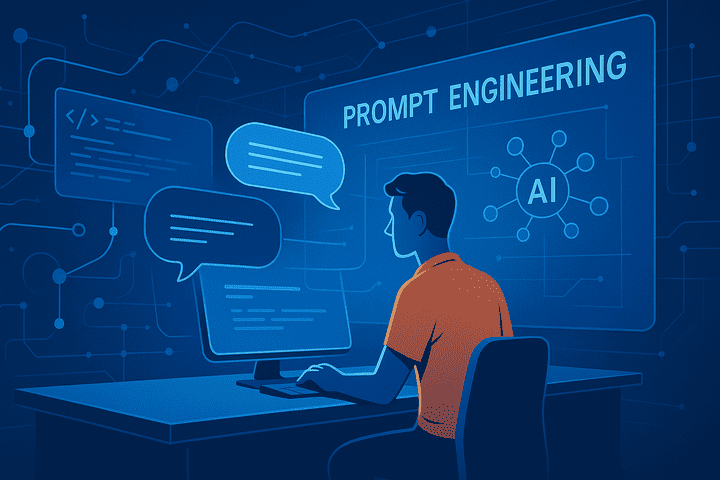Prompt Engineering Best Practices: From Zero to Production

Table of Contents
Introduction
In the age of AI-driven applications, prompt engineering has emerged as a critical skill for unlocking the full potential of large language models (LLMs) such as GPT-4, PaLM, and LLaMA. Whether you’re creating a conversational chatbot, generating marketing copy, or automating data analysis, the quality of your prompt directly impacts the relevance, accuracy, and safety of the model’s output. This article walks you through prompt engineering best practices—from your very first “hello world” prompt to integrating prompts into a robust production workflow.
What Is Prompt Engineering?
Prompt engineering is the art and science of designing input instructions (prompts) for LLMs to guide their behaviour toward desired outcomes. A prompt can be as simple as a single question or as complex as a multi-part system message with strict formatting guidelines. By carefully crafting prompts, you can:
- Shape the tone, style, and scope of responses
- Constrain or expand the model’s creativity
- Embed domain-specific knowledge or guardrails
- Optimize for cost and latency in production
Why Prompt Engineering Matters
Quality & Relevance
Well-engineered prompts yield more accurate, context-aware answers—reducing the need for post-processing or human intervention.Cost Efficiency
Concise, targeted prompts require fewer tokens, lowering API costs such as GPT-3.5 Turbo’s $0.002 per 1,000 tokens.Safety & Compliance
Prompts with explicit ethical instructions and validation steps help prevent toxic or biased outputs, facilitating compliance with regulations like GDPR and CCPA.Scalability
Reusable prompt templates and modular design patterns enable consistent performance across multiple applications and teams.
From Zero: Getting Started with Your First Prompts
Choose Your Model & Interface
- Start with a playground (e.g., OpenAI Playground, Anthropic Claude Studio) for rapid iteration.
- Select the right model tier (e.g., GPT-4 for complex tasks, GPT-3.5 Turbo for straightforward queries).
Define Your Objective
- Ask: What do I want the model to do?
- Example:
Summarize the following text in three bullet points: [INSERT TEXT]
Craft the Minimal Prompt
- Begin with a direct instruction and test variations to observe how phrasing affects output quality.
Iterate & Refine
- Adjust phrasing (“Summarize” → “Provide a concise summary”).
- Experiment with system messages for multi-turn contexts.
Core Best Practices for Prompt Design
1. Be Specific and Unambiguous
- Bad: “Tell me about climate change.”
- Good: “Explain the top three human-driven factors contributing to climate change, in under 100 words.”
2. Use Structure & Formatting
Leverage bullet points, numbered lists, and headings to guide the model’s output:
You are an expert data scientist. Please:
1. Identify three key trends in this dataset.
2. Provide Python code to visualize them.
3. Set Role & Context
Prefix your prompt with a role definition to establish tone and expertise:
“You are a seasoned IT consultant with 10 years of experience.”
4. Provide Examples (Few-Shot Learning)
Show input–output pairs to teach the model your desired format:
Example 1:
Q: What is the capital of France?
A: Paris
Example 2:
Q: What is the largest planet?
A: Jupiter
Now answer:
Q: What is the boiling point of water?
5. Control Creativity & Length
Adjust parameters like temperature, max_tokens, and top_p to balance creativity and precision. Lower temperature (e.g., 0.2–0.4) for deterministic outputs; higher (0.7+) for creative generation.
Advanced Techniques
Chain of Thought Prompting
Encourage the model to “think aloud”:
“Explain your reasoning step by step before giving the final answer.”
Dynamic Prompt Composition
Combine user input with external data:
“Given the latest sales figures [DATA], draft an executive summary highlighting growth drivers.”
Automatic Prompt Tuning
Use reinforcement learning from human feedback (RLHF) or OpenAI’s fine-tuning API to optimize prompts at scale.
Testing & Evaluation
Define Success Metrics
- Accuracy, relevance, diversity, safety incidents, token usage.
A/B Testing
- Compare multiple prompt versions in parallel to identify high performers.
Automated QA Pipelines
- Integrate format and content validation into your CI/CD processes.
Human-in-the-Loop Review
- Periodically audit samples for bias, hallucinations, and compliance.
Integrating Prompts into Production Workflows
Template Management
- Store prompts in a centralized repository or database for versioning.
Parameterization
Use placeholders and metadata tags for dynamic substitution:
“Analyze the sentiment of {{user_comment}} on a scale of 1–5.”
Rate Limiting & Caching
- Cache common queries and apply rate limits to manage API usage and costs.
Monitoring & Logging
- Capture prompt–response pairs, latency, token counts, and error rates. Set up alerts for anomalies.
Tools & Frameworks
- LangChain: Modular framework for prompt templates, chains, and memory.
- PromptLayer: Versioning, analytics, and performance monitoring for prompts.
- OpenAI Fine-Tuning: Tailor model behaviour with your own dataset.
- LlamaIndex: Connect LLMs to external data sources for retrieval-augmented generation (RAG).
Example Scenario: Customer Support Bot
System Message
“You are a friendly support agent for ACME Corp, specializing in troubleshooting network issues.”User Message
“My VPN keeps disconnecting every hour.”Prompt Template
System: {{system_message}} User: {{user_message}} Assistant:Expected Output
- Diagnose likely causes
- Provide step-by-step troubleshooting
- Offer escalation steps if unresolved
Conclusion
Prompt engineering transforms how we harness AI models—moving from ad-hoc experimentation to repeatable, production-ready processes. By following these best practices, you can:
- Achieve consistent, high-quality outputs
- Scale AI-driven features across products
- Ensure compliance, safety, and cost-efficiency
At ASOasis Tech Private Limited, we’re dedicated to helping you build robust AI solutions that deliver real business value. Start applying these strategies today and take your AI projects from concept to production with confidence.
Resources
- OpenAI API Reference: platform.openai.com/docs/api-reference/chat
- LangChain Documentation: python.langchain.com/docs/concepts/prompt_templates/
- PromptLayer Guide: docs.promptlayer.com/why-promptlayer/analytics
- LlamaIndex RAG Overview: docs.llamaindex.ai/en/stable/understanding/rag/
- OpenAI Fine-Tuning: platform.openai.com/docs/guides/fine-tuning